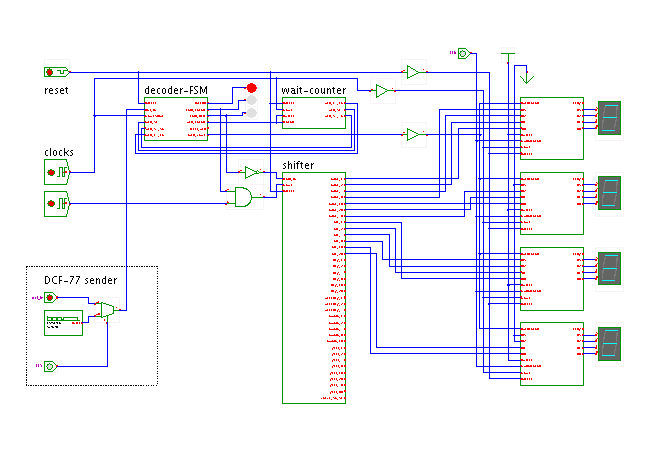

 |  |
 DescriptionThis applet shows a DCF-77 radio controlled digital clock,
realized as a gate-level circuit.
DescriptionThis applet shows a DCF-77 radio controlled digital clock,
realized as a gate-level circuit.
The DCF-77 radio sender is located near Frankfurt in Germany and continuously transmits a 77.5 KHz signal that encodes the local time using amplitude and phase modulation. The sender is controlled by the high-precision atomic clocks of the German institute of standards (Physikalische Bundesanstalt in Braunschweig). The signal can be received almost everywhere in central Europe with very simple and cheap receivers. A short description about the motivation and the encoding of the DCF-77 signal can be found at the www.dcf77.de webpages (in German).
The DCF-77 modulation reduces the signal amplitude for 0.1 seconds (short pulse, 0-bit) or 0.2 seconds (long pulse, 1-bit) at the beginning of each second, allowing to transmit 1 bit of data per second. A simple BCD-encoding scheme is used to transmit the hours, minutes, days, and data information for the next following minute. To allow synchronization into the signal, no pulse is send during the 59th second, so that the start of the next pulse exactly marks the beginning of the minute. The simulation component in the lower left of the applet schematics models this encoding. In real-time simulation, it should be easy to see the generated (active-low) pulses in the output signal. Use the property sheet of the Dcf77Sender component to select the time and data that is transmitted. Please note that the receiver circuit needs to synchronize on the minute start (missing pulse), before it can even begin decoding the signal. Therefore, it might take two minutes of simulation time before the clock circuit shows the correct time. Naturally, the circuit shown here does not include the 'analog' parts of the radio-receiver. If you live in central Europe and want to experiment with the DCF-77 radio signal, a complete receiver module with ferrite antenna is available from Conrad Electronik, www.conrad.de. At the time of writing (2005), their article number is '641138-LN' ('DCF Empfaengerplatine') with a list price of about 10 EUROs. The module generates a digital ouptut of the radio-signal which can then be decoded by your digital hardware or a microcontroller.While the circuit shown provides a working demonstration, a 'real' digital clock needs a much better fault-tolerance, to compensate for a weak, distorted, or noisy radio signal. Unfortunately, designing better algorithms as custom hardware can be hard. Therefore, microcontroller-based decoders are much more common.
Run the applet | Run the editor (via Webstart)